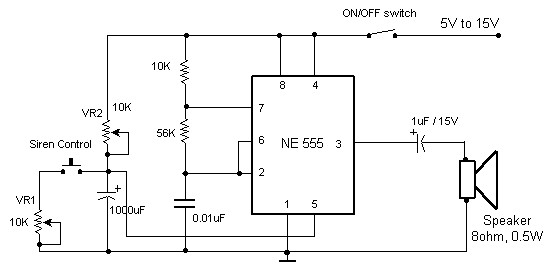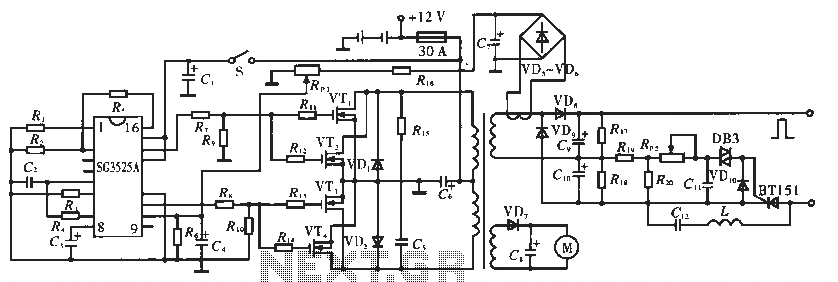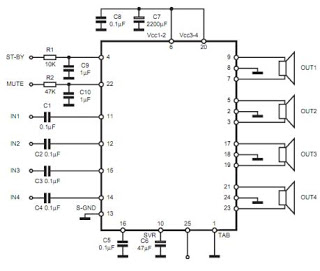
Electronic Siren based NE555

The circuit diagram of an electronic siren based on the NE555 timer produces a sound similar to that of a factory siren. The NE555 timer IC functions as an astable multivibrator with a center frequency of approximately 300 Hz. The frequency is adjustable through pin 5 of the IC. Upon powering the circuit, it operates as a simple fire alarm system using a thermistor as a temperature detector. The thermistor activates a transistor when the temperature exceeds a certain threshold. At high temperatures, the thermistor exhibits low resistance, while at low temperatures, the resistance increases. This characteristic is essential for the circuit's operation. The sound generator simulates a British police car siren and is constructed using two NE555 timer ICs to generate sound frequencies. The 555 timer on the right serves as the alarm sound generator, while the second 555 timer on the left operates at 1 Hz. This straightforward electronic buzzer circuit is designed around the timer, which is configured as an astable multivibrator at about 1 kHz, producing sound when activated. The sound frequency can be adjusted by changing a 10 kΩ resistor, which can be replaced with a variable resistor for more precise control. Additionally, the circuit utilizes a UM3561 sound effect generator chip, which can produce four different sound effects. The UM3561 generates a sound signal that is amplified by a 2N3706 transistor, allowing the sound to be emitted through a speaker. This electronic siren circuit diagram mimics the rise and fall of an American police siren. When initially powered on, the 10 µF capacitors are discharged, and both transistors remain off. When the push-button switch is pressed, the 10 µF capacitor charges through a 22 kΩ resistor, applying voltage to the circuit.
The electronic siren circuit leverages the NE555 timer in an astable mode to create a continuous square wave output, which is vital for generating the characteristic siren sound. The frequency of oscillation is primarily determined by the resistors and capacitors connected to the timer. In this design, the use of a thermistor introduces a safety feature by monitoring temperature variations. The thermistor's resistance changes with temperature, providing an input to the transistor that controls the alarm's activation. This allows the circuit to serve dual purposes: as a sound generator and a temperature-based alarm system.
The integration of the UM3561 chip enhances the circuit's capability by allowing for multiple sound effects, making it versatile for different applications. The output from the UM3561 is directed to the 2N3706 transistor, which acts as a speaker driver, amplifying the sound to a level audible to the human ear. The choice of components, including the use of a push-button switch, provides user control over the circuit, enabling activation and deactivation of the siren sound as needed.
Overall, the design emphasizes simplicity and effectiveness, making it suitable for various applications, including fire alarms and security systems, where audible alerts are necessary. The ability to adjust sound frequency and utilize different sound effects further enhances the functionality of the electronic siren circuit.Here the circuit diagram of electronic siren based NE555. This circuit produces a sound like factory siren. It applies a 555 timer IC which is utilized as an astable multivibrator of a center frequency of about 300Hz. The frequency is controlled by the pin 5 of the IC. When the power supply is switched ON, . The following circuit is a simple fire alarm circuit based NE555 timer and use thermistor as a temperature detector. This sensor will activate the transistor when the temperature is in high value. The thermistor will have a low resistance at high temperature, while at low temperature, the transistor resistance is high. This characteristic of thermitor. This is the sound generator which will simulate British police car siren. The circuit is built using 2 pieces of timer IC 555 to generate sound frequency. How the circuit work: The 555 on the right is wired as an alarm sound generator and the second 555 timer on the left is a 1 Hz.
This easy electronic buzzer circuit built based on timer works for gaining the frequency. The IC timer NE 555 used as astable multivibrator operating at about 1kHz and produces a sound when switched on. The sound frequency can be adjusted by varying the 10K resistor. You may change the 10K resistor with variable resistor. This is a really simple sound effect generator based single sound generator chip UM3561. The UM3561 will generate four kinds of sound effects. The basic operation is that the UM3561 will generate the sound signal, then the signal delivered to 2N3706 (as speaker driver) to be amplified so you can hear the sound from a.
This is Electronic Siren circuit diagram. The sound produced imitates the rise and fall of an American police siren. When first switched on the 10u capacitors is discharged and both transistors are off. When the push button switch is pressed to 10u capacitor will charge via the 22k resistor. This voltage is applied to the. 🔗 External reference
The electronic siren circuit leverages the NE555 timer in an astable mode to create a continuous square wave output, which is vital for generating the characteristic siren sound. The frequency of oscillation is primarily determined by the resistors and capacitors connected to the timer. In this design, the use of a thermistor introduces a safety feature by monitoring temperature variations. The thermistor's resistance changes with temperature, providing an input to the transistor that controls the alarm's activation. This allows the circuit to serve dual purposes: as a sound generator and a temperature-based alarm system.
The integration of the UM3561 chip enhances the circuit's capability by allowing for multiple sound effects, making it versatile for different applications. The output from the UM3561 is directed to the 2N3706 transistor, which acts as a speaker driver, amplifying the sound to a level audible to the human ear. The choice of components, including the use of a push-button switch, provides user control over the circuit, enabling activation and deactivation of the siren sound as needed.
Overall, the design emphasizes simplicity and effectiveness, making it suitable for various applications, including fire alarms and security systems, where audible alerts are necessary. The ability to adjust sound frequency and utilize different sound effects further enhances the functionality of the electronic siren circuit.Here the circuit diagram of electronic siren based NE555. This circuit produces a sound like factory siren. It applies a 555 timer IC which is utilized as an astable multivibrator of a center frequency of about 300Hz. The frequency is controlled by the pin 5 of the IC. When the power supply is switched ON, . The following circuit is a simple fire alarm circuit based NE555 timer and use thermistor as a temperature detector. This sensor will activate the transistor when the temperature is in high value. The thermistor will have a low resistance at high temperature, while at low temperature, the transistor resistance is high. This characteristic of thermitor. This is the sound generator which will simulate British police car siren. The circuit is built using 2 pieces of timer IC 555 to generate sound frequency. How the circuit work: The 555 on the right is wired as an alarm sound generator and the second 555 timer on the left is a 1 Hz.
This easy electronic buzzer circuit built based on timer works for gaining the frequency. The IC timer NE 555 used as astable multivibrator operating at about 1kHz and produces a sound when switched on. The sound frequency can be adjusted by varying the 10K resistor. You may change the 10K resistor with variable resistor. This is a really simple sound effect generator based single sound generator chip UM3561. The UM3561 will generate four kinds of sound effects. The basic operation is that the UM3561 will generate the sound signal, then the signal delivered to 2N3706 (as speaker driver) to be amplified so you can hear the sound from a.
This is Electronic Siren circuit diagram. The sound produced imitates the rise and fall of an American police siren. When first switched on the 10u capacitors is discharged and both transistors are off. When the push button switch is pressed to 10u capacitor will charge via the 22k resistor. This voltage is applied to the. 🔗 External reference





